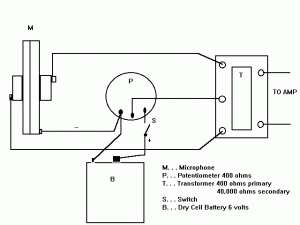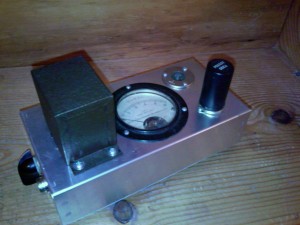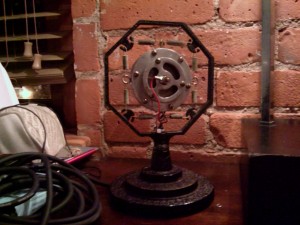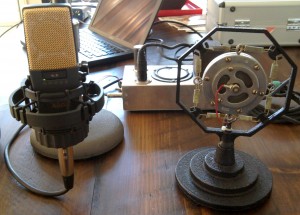When you are creating a set for a musical performance, nothing says ‘old school’ and ‘authentic’ like one of those mics… those real big old mics with the springs… what the F are they called? Turns out that they are called Carbon Microphones, or more specifically, Double Button Carbon Microphones.
And while many a rapper, RnB singer, or songwriter type may favor them for their music video, i can promise you two things: *)no one would be able to actually hook the mic up and use it, and *)if they did, they probably would not dig the sound.
Carbon mics are the oldest microphone technology still in (albeit limited) use today. They actually pre-date vacuum tubes. Wikipedia has a great article on their history and use, so no need for me to retread those waters. Carbon mics are used in landline telephones, so we all have a basic idea of what they sound like. midrangey, a little crunchy (distorted), compressed… hey wait a minute! that sounds pretty good to me! Aren’t there like a million expensive DAW plug-ins in order to give you ‘that sound?’ Anyhow, we all know in general what they sound like… but how do those big old music-video props sound?
In order to find out, it turns out that it’s necessary to actually build a power supply. Carbon mics need a few volts of a DC current moving through them in order to operate. I found this handy schematic online and put it together.
I added a DC voltmeter so that i could monitor the effect of varying the voltage on the sound (the mic i have seems to like 6 volts).
I used a double-button mic input transformer salvaged from an ancient tube PA head that i had. To the output of this transformer i added a second transformer to bring the impedance back down to Low-Z mic impedance so that i could use this whole rig with whatever mic preamp i wanted to. The particular mic i have is a Lifetime Model Six.
I bought it years ago on eBay along with a little tube amp and some shitty speakers (and about a mile of useless rotten old speaker wire) for $150. Anyhow, i won’t bless you with any vocal performances, but here is an acoustic guitar recording from my living room. The left channel is the Carbon mic. The right channel was recorded simultaneously with good equipment (414/omni into an API 512) so you can get a pretty good idea of what i was hearing in the room. I put a little EQ on the Carbon mic to make it more audible (low pass at 3k, 5 db peak at 1.7K). No other processing was used. Check it out.
Does anyone out there use double-button Carbon mics for audio production work these days? Music recording? Sound design work?
I heard recently (maybe Tape Op mag?) that someone was making new-production ‘professional’ carbon mics. Has anyone used these? thoughts?
UPDATE: I recently had the chance to use this Lifetime Model Six Carbon Mic in a modern-recording context. We tracked the following cut at Gold Coast Recorders, using the Lifetime for the vocals. It sounds pretty outstanding… I feel like you could get 90% of the way to this vocal sound with an SM57 and a fuzz pedal, but that extra 10%… it’s a game of inches, ain’t it. This is ATLANTIC CITY, my studio project with T.W. Take a listen: Ten Past Midnight





9 replies on “ICON: “gimme one of those real old mics…” :::UPDATED:::”
I’ve always been curious about these (Bing Carbon mics) :
http://www.myspace.com/carbonmicrophone
and these (The Copperphone) :
http://www.myspace.com/thecopperphone
These types of unique microphones would be a great addition to any mic closet, especially when you’re looking for something that sounds ‘different’.
Instant delta on a 78. Could be a great noise making addition to any dark blues/deltaish tune.
what does instant delta on a 78 mean? i’m in a band, and we do a lot of very soulful blues and folk stuff. two female singers, and we’re looking for a mic that has an old sound. would this work?
Hi lindsey. “Delta” as-in blues music recorded on-location in the mississippi delta region in the 1920s; ’78’meaning 78 RPM records, the old, bandwidth-limited heavy discs… as far as whether or not one of these mics might suit yr group, listen to the audio clip that i posted and see whatcha think! good luck – c.
Hi – I found your site through The Deco Sound blog – they had written an entry about old ring and spring mics and mentioned your name…
I just bought a Webster ring and spring mic on Ebay. It’s a desktop model but can of course be put on a stand. Though it “works”, I’m afraid the sound isn’t powerful enough to use with my burgeoning jazz band… It’s not a static-y sound, but it is very compressed like you mentioned above – and not strong. Not sure the link still works, but here it is:
http://www.ebay.com/itm/220939856014#ht_3638wt_897
I brought it to my local music store and tried it on a vintage Traynor 150 amp and the guy had it turned up to the max and felt that the sound that was emitted wouldn’t be loud enough to be heard in larger venues, especially with drums (though I don’t have any drums in my band..) Can you give me some advice on what I need to do and purchase to safely “boost” the volume? Do I need to make my own version of what you did in this post? Do you construct them and sell them?? I’d hate to not be able to use it!
Thank you so much!
Hi J – yours is a very different mic than the ‘spring’ mics i describe… yr mic is actually much more modern. your mic will be tough to use it live because it’s likely omni-directional.
you should try it as-is. it should word fine, but it will feedback at a pretty low level. If you need better feedback rejection, there are modern mics that LOOK like yours but perform in a manner suitable for modern music. check out: http://www.sontronics.com/saturn.htm
good luck
c.
Thanks so much for the response, Chris – I appreciate it. I will definitely look into this mic you recommended….
[…] For an explanation of WTF this thing is, and why you might possibly need it in your life, see this previous post. […]
I know this article is 12 years old, but I not only have used a carbon button mic in my studio recently (albeit for VFX) but I BUILT a working replica on my 3D printer. ^_^